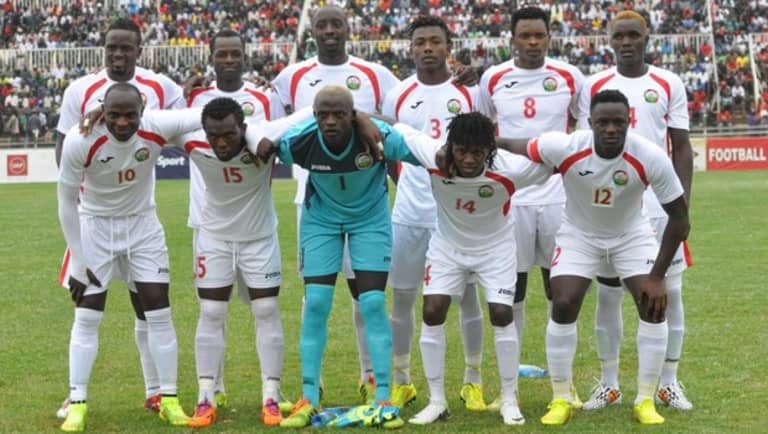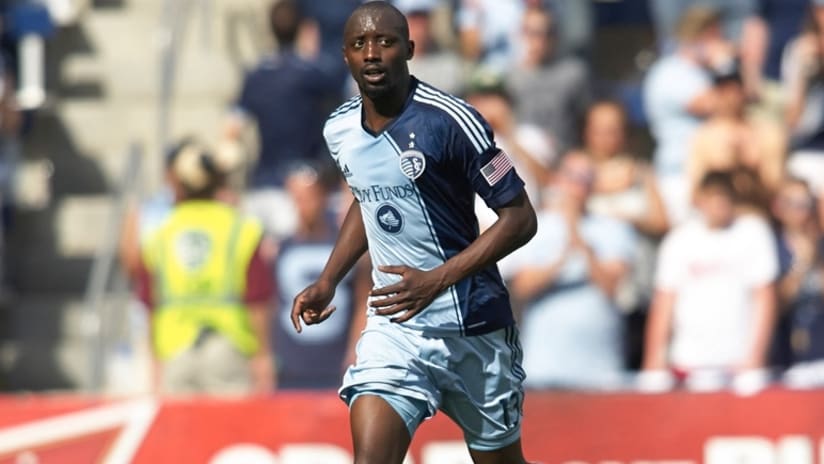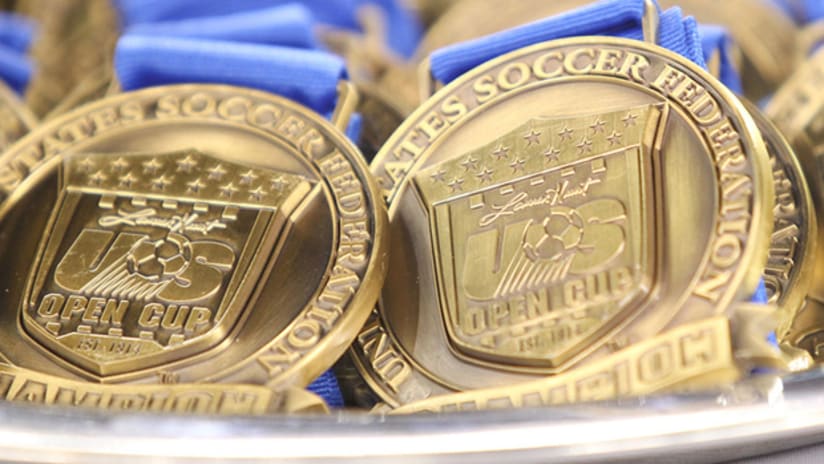It was an afternoon of firsts.
Never before had he donned the red and white kit of the Harambee Stars. Never before had he competed professionally in his hometown. Never before had his father seen him play a professional match.
All of that changed on May 18 of this year, the day Sporting Kansas City midfielder Lawrence Olum made his international debut for Kenya in 2015 Africa Cup of Nations qualifying.
It may have taken him four years at Missouri Baptist University and eight years of climbing from one American soccer division to the next, but at the age of 29, Olum had finally represented his country on the pitch. That he did so in his hometown of Nairobi, and in front of his father and extended family, was all the more rewarding.
“It’s a pleasure to play for the national team,” Olum said. “I had to be patient to get there, so when I did, it was a real blessing.”
Now 30, Olum earned his first cap much later than most international players. Competitive soccer countries assess and cultivate talent pools beginning at the youth level, and players often receive senior team debuts in their late teens or early 20s. Needless to say, his journey strays from the conventional script.
“His hard work in MLS has lent the opportunity for him to get a shot in Kenya,” said Sporting Kansas City manager Peter Vermes. “He would probably say the same thing: better late than never.”
Olum’s international breakthrough—he would make two additional appearances before Kenya was eliminated by Lesotho in the second round of AFCON qualifying—comes during the best season of his Sporting Kansas City career. The 6-foot-2, 185-pound defensive midfielder—nicknamed "Lo" among his teammates—has reached career highs in games (23) and minutes played (1,733). He has netted twogame-winning goals and boasts a 12-5-2 record as a starter, the best on the team among players with at least 10 starts.
“He has an uncanny (knack) for being in big games and winning,” Vermes said. “He has a lot of experience, and he’s only getting better because of the time spent with us.”
Vermes is right: Olum has won four trophies in his last three seasons as a pro. But as the Kenyan is quick to point out, his belated international call-up and increasingly pivotal role for the reigning MLS champions haven’t come without years of diligence in the lower leagues of American soccer.
“I had to prove myself,” Olum said, recalling his first professional stint in 2007 with the Portland Timbers, who then played in the now-defunct USL First Division, the second tier of the American soccer pyramid.
“Coming out of a small school, I never thought anything different. There were all these guys coming from bigger colleges and joining bigger clubs. So the first thing I told myself was to be patient.”
*
When Missouri Baptist’s assistant soccer coach explained to Olum’s parents what a scholarship was, they were sold. They loved the idea of their son playing soccer and receiving an education in the United States.
Olum’s U-18 club coach in Nairobi was a close friend of the Missouri Baptist assistant, who made multiple visits to see Olum and his teammates play in 2002. It didn’t take much convincing for Olum and three of his friends to accept scholarships to the NAIA university located in Creve Coeur, a St. Louis suburb. At 18, Olum left Kenya for the first time and traveled to a country he’d only seen on television.
The move from the Kenyan capital of Nairobi—the largest city in eastern Africa with a population of 3.4 million—to Creve Coeur, an affluent town of 18,000—was an adventure, Olum said. Trading the familiar urban sprawl for gently rolling hills and placid lakes took some getting used to, but the transition was eased by the presence of his three countrymen.
“It was different, and very far from home, but we looked at it as an adventure,” Olum said. “It was a good time for us to be there and see what (the U.S.) was all about.”
Though his new living environment required an adjustment period, Olum had no trouble settling in on the soccer field. Almost always the strongest and most athletic player in NAIA matches, Olum earned Honorable Mention All-American honors as a midfielder in his final three seasons at Missouri Baptist from 2003-2005 before graduating in spring 2006.
After scoring a team-high nine goals for the St. Louis Lions of the USL Premier Development League in fall 2006, Olum signed his first professional contract with Portland in 2007. He quickly realized that nothing would come easy. He always had the strength and athleticism, but his technical skillset and tactical understanding of the game were put to the test.
He spent his first two professional seasons in Portland, where he scored seven goals in 49 games, before joining the Minnesota Thunder in 2009 and the Austin Aztex in 2010. All the while, Olum’s passing, vision and tactical nous were improving to supplement his physicality and aerial prowess.
In Austin, he he was united with coach Adrian Heath, the manager who will lead Orlando City SC’s transition to Major League Soccer in 2015 as an expansion team. Under his tutelage, Olum played nearly every game he was available.
“Coach Heath helped me improve a lot,” Olum said. “He spent more time with me on how I could see the game and read the game. I increased my speed and awareness on the field and was getting all those repetitions.”
When Heath left Austin for Orlando City SC’s inaugural USL PRO campaign in 2011, he brought Olum with him. This, Olum believes, this was the year he put all the pieces together. This was the year that changed the path of his career.
A consistent starter in the midfield, Olum helped Orlando City win the Commissioners’ Cup in the club’s first year of existence. It was his first title as a professional, and it set the stage for him to shine in the playoffs.
On Sept. 3, 2011, Olum scored Orlando City’s opening goal in the USL PRO championship, a match his team would win in a penalty shootout. Just 12 days later, he had signed his first MLS contract after a successful weeklong trial.
At the age of 27, nine years after he first came to the U.S., Olum had reached the top level of American soccer. His new club was Sporting Kansas City.
*
Olum acknowledges that it’s rare for a player to receive his first international cap at the age of 29. However, he believes his debut could have come more than four years earlier if not for Kenya’s status as a Third World country.
Kenya first expressed interest in Olum in 2009, but the fact that he played professionally in the U.S. prevented any move from materializing. The $3,000 plane ticket that the Kenya Football Federation would have to pay to transport Olum from the U.S. to Africa was too expensive.
“Kenya is a Third World country,” he said. “To them, paying a ticket for $3,000 is a big deal. And if you do that for 10 players, it becomes very hard. They don’t look into getting players from America because of the cost.”
To complicate matters, Kenya had struggled to keep a head coach, going through eight managers from 2007-2012. When it was time for the national team coach to pick his squad, he often selected players from Kenya’s top division to minimize travel costs and appease Kenyan fans who were familiar only with domestic league talents. Olum was close to joining the Harambee Stars multiple times during this period, but arrangements always fell through.
The only way Olum could earn that elusive cap was to become too good for Kenya’s manager—whomever it was—to pass up. He saw his tenure at Sporting Kansas City as an opportunity to make a statement.
He made 21 League appearances for the club in 2012, serving in midfield and defense. It was yet another tremendous period of individual growth, as Vermes and the coaching staff helped him become fitter and more aggressive to supplement the team’s high-pressure style of play. He added three starts in the Lamar Hunt U.S. Open Cup, including a 120-minute centerback performance in the Final against Seattle Sounders FC. The penalty shootout victory not only cemented Sporting Kansas City’s status as an elite MLS club, but showcased Olum’s versatility.
“It’s great to have a guy like him on your roster because he is able to fill different positions,” said Sporting Kansas City captain Matt Besler, who partnered Olum in central defense for the Open Cup Final. “He understands the game and understands what’s required as a centerback and as a holding mid.”
The Open Cup result caught Kenya’s attention. Olum trained with the Harambee Stars for the first time in November 2012 ahead of the CECAFA Challenge Cup hosted in Uganda, but his first cap never came.
*
The 2013 MLS Cup Final was a precursor of things to come in 2014 for Olum and Sporting Kansas City.
Defensive midfielder Uri Rosell started the match and Olum was on the substitutes bench. After just eight minutes, the Spaniard suffered a left ankle sprain, and Olum was summoned to action on the grandest stage of American soccer.
Sporting Kansas City’s thrilling win on penalties delivered Olum his fourth trophy in three seasons and marked the first time a Kenyan had won MLS Cup. When his team needed someone to step up, he was there to answer the call.
Such has been the case in 2014. Already facing a slew of injuries, Sporting Kansas City transferred Rosell to Portugal’s Sporting CP in early June. Yet Vermes wasn’t concerned.
“We knew we had Lawrence, who had played in that position many times and filled the role well,” Vermes said. “He brings a different dimension—he’s a very powerful guy, he reads the game well, he’s deceptively fast. He also has a winning mentality.”
Indeed, Olum hasn’t finished a season without a trophy since 2010. He has transitioned to a full-time starter this campaign, and his contribution has not gone unnoticed. Besler lauds his poise, passing and aerial ability.
“He’s always been a talented player, but this year we’ve needed him to step up, and he has,” Besler said. “For us right now, the situation is that we need someone to step up in that defensive midfielder role. He’s taken that position and made it his own.”
Like Olum, Besler’s first cap for the U.S. Men’s National Team came later than normal. The Kansas native didn’t play for the U.S. until Jan. 29, 2013, two weeks before his 26th birthday. So when Olum finally featured for Kenya this summer, Besler was thrilled.
“I know firsthand that every player’s path to the national team is different,” Besler said. “As players, we’re all very excited to see him get the opportunity. We know he still has a lot of family and friends back home in Kenya, and the culture means a lot to him. We’re all really happy that he got the chance.”
*

His father and other family members were in the stands at Nyayo National Stadium as the Harambee Stars made a victorious start to AFCON qualifying.Olum was rewarded for his patience on a sunny Sunday afternoon this past May. Twelve years after leaving Nairobi to pursue an education and playing career in the U.S., Olum was back in his hometown playing for Kenya.
“My mother had seen me play and came to the U.S. to visit a couple times, but my dad and the rest of my family had never seen me play in a professional setting,” he said. “It was a great feeling.”
As gratifying as the moment was, Olum doesn’t see it as a culmination of his journey. Rather, he wants his career to continue at an upward trajectory, the way it has since he came to this country more than a decade ago.
Above all, he wants to help Sporting Kansas City defend the MLS Cup. He wants to play for Kenya as long as the manager keeps calling. He also has a long-term vision, one he frequently reflects upon.
“I want to leave a positive mark on this club,” Olum said. “If somebody else saw me play, I want them to think, “Wow, there are some things we can learn from him.”
At the very least, one could learn a thing or two about patience.




